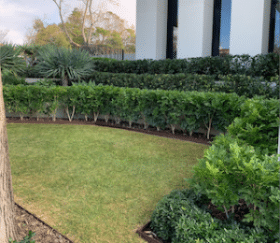We all need a haircut now and then. Our plants are no different!
Every living thing needs a little TLC. A regular trim, also known as pruning, is a great way to achieve this for hedges, shrubs and bushes.
Pruning can help to:
- maintain a manageable height
- create special shapes/growth habits (e.g. topiary, standards, espaliered plants)
- remove unhealthy growth like dead/diseased branches, water shoots and suckers
- improve airflow, light, and water penetration
- reduce competition/overcrowding
- grow better fruit and flowers
- stimulate new growth
- improve plant health
- add ‘curbside appeal’ to your home.
For those new to pruning, knowing when and where to start, and how far to go without damaging delicate plants, can be intimidating.
Fear not! This blog post gives our top tips on how to prune hedges and bushes like an expert!
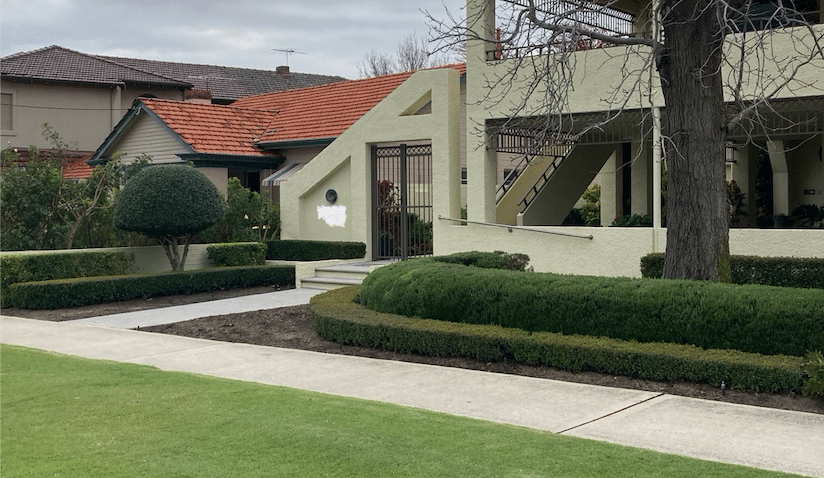
Click to read what you'll find in this post
What’s the Difference Between Hedges, Bushes and Shrubs?
These terms are often used interchangeably, but there are differences.
What is a Hedge?
A group of bushes or shrubs, closely planted to:
- create privacy
- act as a fence/boundary/windbreak or
- fit an aesthetic theme (e.g. formal gardens).
What is a Bush?
A small, woody plant, with dense, low-growing branches, typically up to 2.5m tall.
Bushes fill spaces, add contrast, and can be decorative showpieces!
Popular ornamentals include camelias, azaleas, and hydrangeas.
What is a Shrub?
It’s like a bush, but larger — up to 6m tall.
Shrubs can stand alone, or be massed together as hedges. They can be used to:
- shelter plants, livestock or buildings from sun/weather
- attract wildlife
- add colour/texture/contrast to gardens
- create topiary (decorative shaped bushes).
When to Trim Hedges and Shrubs in Perth
When you prune depends on the plant, and why it needs pruning — for example, appearance, manageability, or plant health.
Some pruning can be done almost anytime — for example, removing dead branches, suckers, water shoots, diseased or damaged growth.
Late winter, after the coldest weather is over, is usually best for annual pruning, especially for summer and autumn-flowering plants. This promotes healthy spring growth.
The general rule is to prune after flowering or fruiting. Spring-flowering plants are pruned after flowering ends.
Be cautious about autumn pruning though — new growth can be damaged by winter cold. Prune deciduous plants lightly soon after planting, then again in winter when dormant. Summer maintenance pruning stimulates growth. Plant evergreens in spring and trim them immediately, then biannually. Trim more frequently for a denser hedge.
Light Trimming and Tip Pruning
Light pruning suits young plants that might be damaged by hard pruning. Even before plants grow together to form a hedge, regular light trimming improves foliage density, for a well-formed hedge.
A light all-over trim using shears or a hedge-trimmer also helps to shape shrubs.
Removing deadheads and deadwood improves plant health. Trim at the 2nd or 3rd eye bud, immediately below the flower-bearing stalk.
To tip or pinch-prune, remove the ends of shoots during the growing season, pinching them out by hand. This encourages new shoots, shapely growth, and more flowers.
Moderate Trimming/Pruning
Moderate pruning suits established plants.
Cut healthy shoots back by about one-third of the whole plant, or half the previous year’s growth, to about 45-60cm from the base.
This stimulates more new growth than light pruning.
Hard Trimming/Pruning
Hard pruning (rejuvenation pruning) can be beneficial where pruning is long overdue.
It is especially appropriate for:
- plants that get badly out of control like honeysuckle
- vigorous deciduous species like forsythia and viburnum
- common hedging plants like privet and Japanese holly
- multi-stemmed shrubs like lilacs and roses.
Hard pruning of healthy plants to about 20-30cms above the ground encourages the plant to grow into a better shape.
Avoid hard pruning of unhealthy plants, as it can send them into shock.
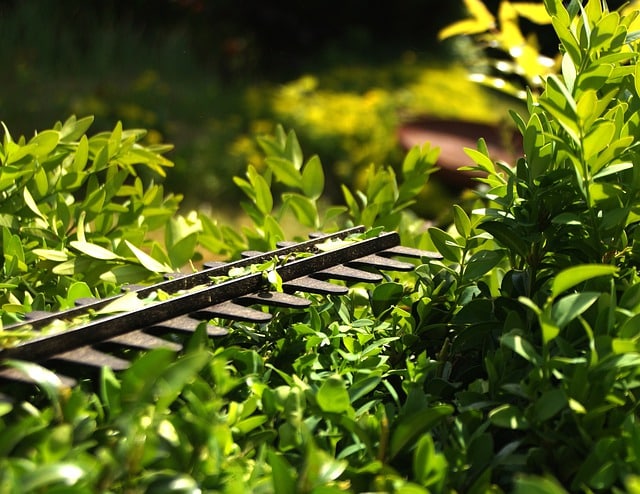
What Tools to Use to Trim a Hedge
You are only as good as your tools — so invest in the right tools for the job.
Buy the best you can afford to make it both easier for you and better for the hedges — ground-steel blades and gear technology can help maximise cutting power.
Keep tools sharp and well-oiled. Blunt blades don’t cut cleanly, damaging plants.
Our list of must-have tools includes:
- Secateurs: your go-to hand tool for pruning, trimming, and deadheading. Choose secateurs with a bypass blade and gears.
- Hedging Snips: a light, sharp hand tool, with long flat blades — useful for fine trimming of leaves and small stems.
- Lopper: long-handled secateurs for pruning high branches, tall hedges and dead wood.
- Pole Pruner: a small saw/secateur, mounted on a telescopic pole (manual or powered), used for safely trimming high branches.
- Hedge Shears/Clippers: long-bladed hand tool for light trimming/shaping of shrubs and straight edges (e.g hedges).
- Pruning Saw: a small, sharp hand saw, for branches up to 10cm thick. The narrow blade accesses dense foliage.
- Hedge Trimmer: a motorised saw, optimal for trimming large/formal hedges efficiently. Choose from petrol, mains-electric, or battery-powered options.
- Chainsaw: useful for big jobs, but less precise than hedge trimmers/shears. Use very carefully to avoid injury!
For assistance with hedge-trimming, contact us at Perth Gardening Experts. We use commercial-grade electric tools — much quieter and more environmentally friendly than petrol-powered tools. And our team are experts at trimming and shaping hedges.
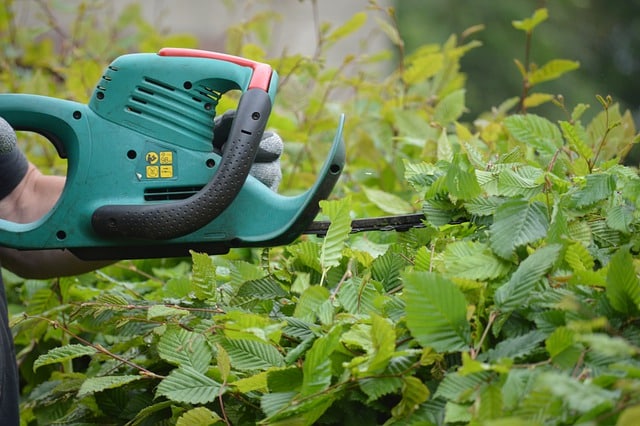
How to Trim Hedges Correctly
Why trim hedges correctly?
Correct trimming keeps hedges compact and attractive, and stimulates growth.
Incorrect pruning can weaken plants and look terrible.
Step 1: Prepare Your Environment
Have a plan. Consider the weather — don’t prune in wind or rain.
Ensure hand-tools are sharp and power tools are fueled/charged.
Wear safety goggles, non-slip boots, sturdy gloves, and protective clothing (long pants/sleeves).
If you aren’t confident to cut by eye, set string lines to help you cut straight. Save on clean-up time by using a drop-sheet to catch clippings.
Step 2: Remove Dead and Diseased Branches
Remove dead and diseased branches first.
Cut problem limbs back to their base, or to a strong lateral branch or shoot. This stops disease from spreading further, improves nutrient uptake, and encourages growth.
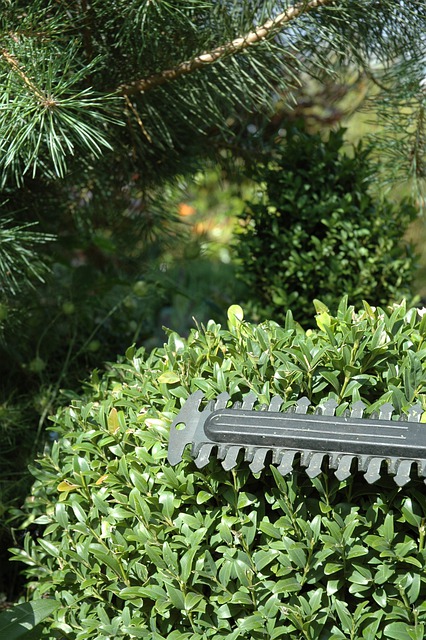
Step 3: Trim and Shape the Hedge
Trim protruding branches, then fine prune, for a smooth surface appearance. Start slowly — you can always take more off later, but you can’t put anything back!
For medium-height hedges, trim sides first, from back to front, cutting vertically. Prune the top horizontally, positioning your saw at a slight angle.
For tall hedges, trim the top first, then the sides. If using a ladder, tie it to a tree, or have someone hold it.
Always hold the cutting blade close to the main stem, cutting cleanly without tearing. Cut just outside the branch collar (where the branch begins). Don’t leave stubs — these encourage pests and diseases. Make your hedge wider at the base, so sunlight can reach lower areas.
NOTE: If you aren’t comfortable climbing a ladder, call our team at Perth Gardening Experts on 08 6263 4645! Our expert staff safely prune hedges up to 3m in height.
Step 4: After Pruning
Dispose of clippings by:
- composting
- mulch
- green-waste recycling.
Feed your shrubs after pruning, using the right fertiliser for the type of plant.
Conclusion on How to Trim Hedges
Now you know why effective hedge trimming is vital to keep it healthy and immaculate.
You also know how and when to prune, to make your shrubs a stunning garden feature.
But let’s face it, we all just have way too much on our plate at times!
So before your hedge gets out of hand, and if you are worried about safety or achieving a beautiful end result, call Perth Gardening Experts and we’ll take care of it for you.
Whether it’s a one-off visit you need, or a convenient long-term maintenance package, we can help!
Call us on 08 6263 4645 or get in touch online — our friendly team are happy to discuss how PGE can help keep your garden looking great!

